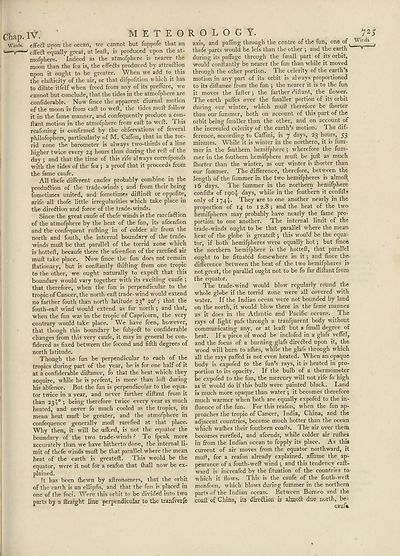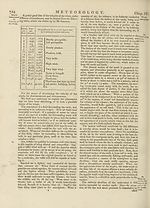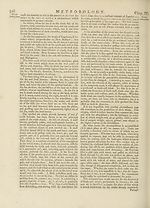Encyclopaedia Britannica, or, a Dictionary of arts, sciences, and miscellaneous literature : enlarged and improved. Illustrated with nearly six hundred engravings > Volume 13, MAT-MIC
(771) Page 725
Download files
Complete book:
Individual page:
Thumbnail gallery: Grid view | List view

Chap
Winds.
. IV. ' M E T E O
effeft upon the ocean, we cannot but fuppofe that an
effect equally great, at leaft, is produced ^ upon the at-
mofphere. Indeed as the atmofphere is nearer the
moon than the fea is, the effefts produced by attraction
upon it ought to be greater. When we add to this
the elafticity of the air, or that difpofition which it has
to dilate itfelf when freed from any of its preffure, we
cannot but conclude, that the tides in the atmofphere are
eonfiderable. Now fince the apparent diurnal motion
of the moon is from eaft to weft, the tides muft follow
it in the fame manner, and confequently produce a^con-
ftant motion in the atmofphere from eaft to weft. This
reafoning is confirmed by the obfervations of feveral
philofophers, particularly of M. Caflon, that in the tor¬
rid zone the barometer is always two-thirds of a line
higher twice every 24 hours than during the reft of the
day •, and that the time of this rife always correfponds
with the tides of the fea 5 a proof that it proceeds from
the fame caufe.
All thefe different caufes probably combine in the
produftion of the trade-winds •, and from their being
fometimes united, and fometimes diftinft or oppofite,
arife all thofe little irregularities which take place in
the direction and force of the trade-winds.
Since the great caufe of thefe winds is the rarefaftion
of the atmofphere by the heat of the fun, its afcenfion
and the confequent rufhing in of colder air from the
north and fouth, the internal boundary of the trade-
winds muft be that parallel of the torrid zone which
is hotteft, becaufe there the afcenfion of the rarefied air
muft take place. Now fince the fun does not remain
ftationary, but is conftantly ftiifting from one tropic
to the other, we ought naturally to expedt that this
boundary would vary together with its exciting caufe j
that therefore, when the fun is perpendicular to the
tropic of Cancer, the north-eaft trade-wind would extend
no farther fouth than north latitude 230 30^ } that the
fouth-eaft wind would extend as far north j and that,
when the fun wras in the tropic of Capricorn, the very
contrary would take place. We have feen, howrever,
that though this boundary be fubjedf to confiderable
changes from this very caufe, it may in general be con-
fidered as fixed between the fecond and fifth degrees of
north latitude.
Though the fun be perpendicular to each of the
tropics during part of the year, he is for one half of it
at a confiderable diftance, fo that the heat which they
acquire, while he is prefent, is more than loft during
his abfence. But the fun is perpendicular to the equa¬
tor twice in a year, and never farther diftant from it
than 23^° •, being therefore twice every year as much
heated, and never fo much cooled as the tropics, its
mean heat muft be greater, and the atmofphere in
confequence generally moft rarefied at that place.
Why then, it will be 'alked, is not the equator the
boundary of the two trade-winds ? To fpeak more
accurately than we have hitherto done, the internal li¬
mit of thefe winds muft be that parallel where the mean
heat of the earth is greateft. This would be the
equator, were it not for a reafon that ftiall now be ex¬
plained.
It has been fhewn by aftronomers, that the orbit
of the earth is an ellipfis, and that the fun is placed in
one of the foci. Were this orbit to be divided into two
parts by a ftraight line perpendicular to the tranfverfe
R O L O G Y.
axis, and pafling through the centre of the fun, one of
thefe parts would be lefs than the other ) and the earth
during its paffage through the fmall part of its orbit,
would conftantly be nearer the fun than while it moved
through the other portion. The celerity of the earth’s
motion in any part of its orbit is always proportioned
to its diftance from the fun } the nearer it is to the fun
it moves the fafter ; the farther diftant, the flower.
The earth paffes over the fmaller portion of its orbit
during our winter, which muft therefore be ftiorter
than our fummer, both on account of this part of the
orbit being fmaller than the other, and on account of
the increafed celerity of the earth’s motion. I he dif¬
ference, according to Caflini, is 7 days, 23 hours, 53
minutes. While it is winter in the northern, it is fum¬
mer in the fouthern hemifphere 5 wherefore the fum¬
mer in the fouthern hemifphere muft be juft as much
ftiorter than the winter, as our winter is ihorter than
our fummer. The difference, therefore, between the
length of the fummer in the two hemifpheres is almoft
16 days. The fummer in the northern hemifphere
confifts of ipo^ days, while in the fouthern it confifts
only of 174^. They are to one another nearly in the
proportion of 14 to 12.8 j and the heat of the two
hemifpheres may probably have nearly the fame pro¬
portion to one another. The internal limit of the
trade-winds ought to be that parallel w'here the mean
heat of the globe is greateft ; this would be the equa¬
tor, if both hemifpheres were equally hot 5 but fince
the northern hemifphere is the hotteft, that parallel
ought to be fituated fomewhere in it ; and fince the-
difference between the heat of the two hemifpheres is
not great, the parallel ought not to be fo far diftant from
the equator.
The trade-wind would blow regularly round the
whole globe if the torrid zone were all covered with
water. If the Indian ocean were not bounded by land
on the north, it would blow there in the fame mannep
as it does in the Atlantic and Pacific oceans. . The
rays of light pafs through a tranfparent body without
communicating any, or at leaft but a fmall degree of
heat. If a piece of wood be inclofed in a glafs veffel,
and the focus of a burning-glafs diredled upon it, the
wood will burn to alhes, while the glafs through which
all the rays paffed is not even heated. When an opaque
body is expofed to the fun’s rays, it is heated in pro¬
portion to its opacity. If the bulb of a thermometer
be expofed to the fun, the mercury will not rife fo high
as it would do if this bulb were painted black. Land
is much more opaque than water ; it becomes therefore
much warmer when both are equally expofed to the in¬
fluence of the fun. For this reafon, when the fun ap¬
proaches the tropic of Cancer, India, China, and the
adjacent countries, become much hotter than the ocean
which w'afties their fouthern coatls. The air over them
becomes rarefied, and afcends, while colder air rufhes
in from the Indian ocean to fupply its place. As thi*
current of air moves from the equator northward, it
muft, for a reafon already explained, affume the ap¬
pearance of a fouth-weft wind ; and this tendency eaft-
ward is increafed by the fituation of the countries to
which it flows. 'Phis is the caufe of the fouth-weft
monfoon, which blows during fummer in the northern
parts of the Indian ocean. Between Borneo and the
coaft of China, its diredion is almoft due north, be-
cauf*.
72.
Wirds
Winds.
. IV. ' M E T E O
effeft upon the ocean, we cannot but fuppofe that an
effect equally great, at leaft, is produced ^ upon the at-
mofphere. Indeed as the atmofphere is nearer the
moon than the fea is, the effefts produced by attraction
upon it ought to be greater. When we add to this
the elafticity of the air, or that difpofition which it has
to dilate itfelf when freed from any of its preffure, we
cannot but conclude, that the tides in the atmofphere are
eonfiderable. Now fince the apparent diurnal motion
of the moon is from eaft to weft, the tides muft follow
it in the fame manner, and confequently produce a^con-
ftant motion in the atmofphere from eaft to weft. This
reafoning is confirmed by the obfervations of feveral
philofophers, particularly of M. Caflon, that in the tor¬
rid zone the barometer is always two-thirds of a line
higher twice every 24 hours than during the reft of the
day •, and that the time of this rife always correfponds
with the tides of the fea 5 a proof that it proceeds from
the fame caufe.
All thefe different caufes probably combine in the
produftion of the trade-winds •, and from their being
fometimes united, and fometimes diftinft or oppofite,
arife all thofe little irregularities which take place in
the direction and force of the trade-winds.
Since the great caufe of thefe winds is the rarefaftion
of the atmofphere by the heat of the fun, its afcenfion
and the confequent rufhing in of colder air from the
north and fouth, the internal boundary of the trade-
winds muft be that parallel of the torrid zone which
is hotteft, becaufe there the afcenfion of the rarefied air
muft take place. Now fince the fun does not remain
ftationary, but is conftantly ftiifting from one tropic
to the other, we ought naturally to expedt that this
boundary would vary together with its exciting caufe j
that therefore, when the fun is perpendicular to the
tropic of Cancer, the north-eaft trade-wind would extend
no farther fouth than north latitude 230 30^ } that the
fouth-eaft wind would extend as far north j and that,
when the fun wras in the tropic of Capricorn, the very
contrary would take place. We have feen, howrever,
that though this boundary be fubjedf to confiderable
changes from this very caufe, it may in general be con-
fidered as fixed between the fecond and fifth degrees of
north latitude.
Though the fun be perpendicular to each of the
tropics during part of the year, he is for one half of it
at a confiderable diftance, fo that the heat which they
acquire, while he is prefent, is more than loft during
his abfence. But the fun is perpendicular to the equa¬
tor twice in a year, and never farther diftant from it
than 23^° •, being therefore twice every year as much
heated, and never fo much cooled as the tropics, its
mean heat muft be greater, and the atmofphere in
confequence generally moft rarefied at that place.
Why then, it will be 'alked, is not the equator the
boundary of the two trade-winds ? To fpeak more
accurately than we have hitherto done, the internal li¬
mit of thefe winds muft be that parallel where the mean
heat of the earth is greateft. This would be the
equator, were it not for a reafon that ftiall now be ex¬
plained.
It has been fhewn by aftronomers, that the orbit
of the earth is an ellipfis, and that the fun is placed in
one of the foci. Were this orbit to be divided into two
parts by a ftraight line perpendicular to the tranfverfe
R O L O G Y.
axis, and pafling through the centre of the fun, one of
thefe parts would be lefs than the other ) and the earth
during its paffage through the fmall part of its orbit,
would conftantly be nearer the fun than while it moved
through the other portion. The celerity of the earth’s
motion in any part of its orbit is always proportioned
to its diftance from the fun } the nearer it is to the fun
it moves the fafter ; the farther diftant, the flower.
The earth paffes over the fmaller portion of its orbit
during our winter, which muft therefore be ftiorter
than our fummer, both on account of this part of the
orbit being fmaller than the other, and on account of
the increafed celerity of the earth’s motion. I he dif¬
ference, according to Caflini, is 7 days, 23 hours, 53
minutes. While it is winter in the northern, it is fum¬
mer in the fouthern hemifphere 5 wherefore the fum¬
mer in the fouthern hemifphere muft be juft as much
ftiorter than the winter, as our winter is ihorter than
our fummer. The difference, therefore, between the
length of the fummer in the two hemifpheres is almoft
16 days. The fummer in the northern hemifphere
confifts of ipo^ days, while in the fouthern it confifts
only of 174^. They are to one another nearly in the
proportion of 14 to 12.8 j and the heat of the two
hemifpheres may probably have nearly the fame pro¬
portion to one another. The internal limit of the
trade-winds ought to be that parallel w'here the mean
heat of the globe is greateft ; this would be the equa¬
tor, if both hemifpheres were equally hot 5 but fince
the northern hemifphere is the hotteft, that parallel
ought to be fituated fomewhere in it ; and fince the-
difference between the heat of the two hemifpheres is
not great, the parallel ought not to be fo far diftant from
the equator.
The trade-wind would blow regularly round the
whole globe if the torrid zone were all covered with
water. If the Indian ocean were not bounded by land
on the north, it would blow there in the fame mannep
as it does in the Atlantic and Pacific oceans. . The
rays of light pafs through a tranfparent body without
communicating any, or at leaft but a fmall degree of
heat. If a piece of wood be inclofed in a glafs veffel,
and the focus of a burning-glafs diredled upon it, the
wood will burn to alhes, while the glafs through which
all the rays paffed is not even heated. When an opaque
body is expofed to the fun’s rays, it is heated in pro¬
portion to its opacity. If the bulb of a thermometer
be expofed to the fun, the mercury will not rife fo high
as it would do if this bulb were painted black. Land
is much more opaque than water ; it becomes therefore
much warmer when both are equally expofed to the in¬
fluence of the fun. For this reafon, when the fun ap¬
proaches the tropic of Cancer, India, China, and the
adjacent countries, become much hotter than the ocean
which w'afties their fouthern coatls. The air over them
becomes rarefied, and afcends, while colder air rufhes
in from the Indian ocean to fupply its place. As thi*
current of air moves from the equator northward, it
muft, for a reafon already explained, affume the ap¬
pearance of a fouth-weft wind ; and this tendency eaft-
ward is increafed by the fituation of the countries to
which it flows. 'Phis is the caufe of the fouth-weft
monfoon, which blows during fummer in the northern
parts of the Indian ocean. Between Borneo and the
coaft of China, its diredion is almoft due north, be-
cauf*.
72.
Wirds
Set display mode to:
![]() Universal Viewer |
Universal Viewer | ![]() Mirador |
Large image | Transcription
Mirador |
Large image | Transcription
Images and transcriptions on this page, including medium image downloads, may be used under the Creative Commons Attribution 4.0 International Licence unless otherwise stated. ![]()
| Permanent URL | https://digital.nls.uk/192694073 |
|---|
| Attribution and copyright: |
|
|---|
| Description | Ten editions of 'Encyclopaedia Britannica', issued from 1768-1903, in 231 volumes. Originally issued in 100 weekly parts (3 volumes) between 1768 and 1771 by publishers: Colin Macfarquhar and Andrew Bell (Edinburgh); editor: William Smellie: engraver: Andrew Bell. Expanded editions in the 19th century featured more volumes and contributions from leading experts in their fields. Managed and published in Edinburgh up to the 9th edition (25 volumes, from 1875-1889); the 10th edition (1902-1903) re-issued the 9th edition, with 11 supplementary volumes. |
|---|---|
| Additional NLS resources: |
|

